 To enhance service speed and avoid tariff delays, we've opened a US warehouse. All US orders ship directly from our US facility.
To enhance service speed and avoid tariff delays, we've opened a US warehouse. All US orders ship directly from our US facility.
| Cat. No. | Product Name | Field of Application | Chemical Structure |
|---|---|---|---|
| DC65857 | BAmP-O16B |
BAmP-O16B is an ionizable cationic amino lipid that has been used in the generation of lipid nanoparticles (LNPs).
More description
|

|
| DC65856 | Lipid C3 |
Lipid C3 is an ionizable cationic lipid (pKa = 5.05-5.671).1,2 It has been used in the formation of lipid nanoparticles (LNPs) for the delivery of mRNA in vitro and in vivo.
More description
|

|
| DC67122 | Lipid 50 |
Lipid 50 (compound 50) is an ionizable lipid that can be used for the generation of lipid nanoparticles (LNPs). Lipid 50 is a carrier for both siRNA and mRNA.
More description
|
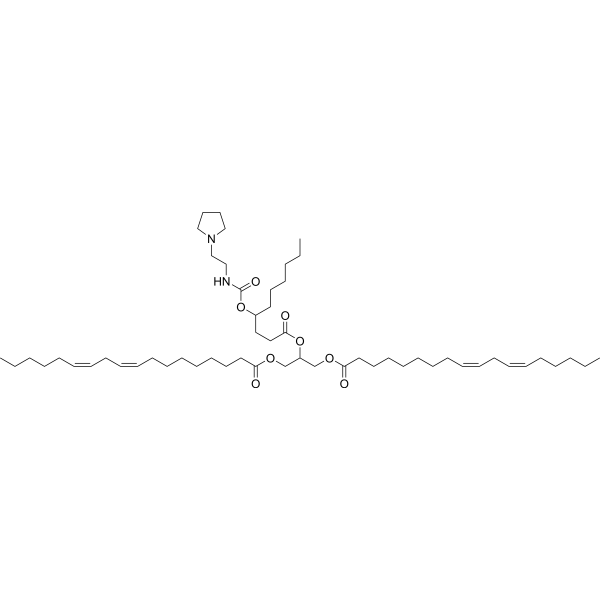
|
| DC65854 | PPPDA-O16B |
PPPDA-O16B is a disulfide bond-containing ionizable cationic lipid that has been used in the generation of lipid nanoparticles (LNPs) for plasmid delivery in vitro and in vivo.
More description
|

|
| DC67133 | C10-200 |
C10-200-based LNPs show enhanced liver tropism for mRNA delivery, outperforming branched-chain lipidoids (e.g., C12-200) in hepatic reporter gene expression. The system's therapeutic potential is confirmed through successful EPO production, with measurable increases in circulating protein levels following administration.
More description
|

|
| DC65853 | (S)-C12-200 |
(S)-C12-200 is an ionizable cationic lipid (pKa = 7.12) and an isomer of C12-200 (Item No. 36699).1 It has been used in the formation of lipid nanoparticles (LNPs) for the delivery of mRNA in vivo.
More description
|
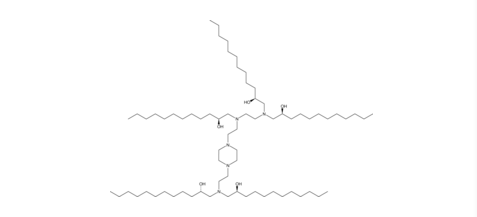
|
| DC65852 | C3-K2-E14 |
C3-K2-E14 is an ionizable cationic lipid (pKa = 5.5).1 It has been used in the generation of lipid nanoparticles (LNPs) for the delivery of mRNA or siRNA in vitro and in vivo.
More description
|

|
| DC67485 | A1-28 |
A1-28 is a redox-responsive ionizable lipid featuring a disulfide linkage, designed for CRISPR component delivery. Its LNP formulations effectively package both Cas9 mRNA and sgRNA, enabling efficient genome editing in cultured cells.
More description
|

|
| DC65850 | VL422 |
VL422 is an ionizable cationic lipid.1 It has been used in the generation of lipid nanoparticles (LNPs) for the delivery of CRISPR complementary single-guide RNA (sgRNA) and Cas9 mRNA for gene editing in vitro and in vivo. LNPs containing VL422 and encapsulating Cas9 mRNA and sgRNA targeting the gene encoding angiopoietin-related protein 3 (ANGPTL3), a protein whose loss-of-function decreases LDL, HDL, and cholesterol plasma levels, induce a deletion in a premature stop codon in ANGPTL3 in the livers of cynomolgus monkeys.
More description
|

|
| DC60405 | C13-112-tri-tail |
C13-112-tri-tail is a synthetic ionizable lipid molecule designed for use in lipid nanoparticles (LNPs) for the delivery of anionic substrates, such as nucleic acids (e.g., siRNA, mRNA) and proteins.
More description
|

|
| DC67490 | G0-C14 analog |
G0-C14 analog is a derivative of the ionizable cationic lipid G0-C14.
More description
|

|
| DC65858 | Lipid OA2 (hydrochloride) |
Lipid OA2 is an ionizable cationic lipid that has been used in the generation of single-component lipid nanoparticles (LNPs) for the delivery of siRNA.
More description
|

|
| DC67511 | ALC-0315 N-oxide |
ALC-0315 N-oxide represents a potential oxidative degradation product that may be present in formulated batches of the cationic lipid ALC-0315.
More description
|

|
| DC60485 | IAJD93 |
IAJD93(IAJD-93) is a pentaerythritol-based one-component ionizable amphiphilic Janus Dendrimer (IAJD), delivery systems for mRNA delivery.
More description
|

|
| DC65621 | 1,2(R)-Dioleyloxy-3-dimethylamino-propane |
1,2(R)-Dioleyloxy-3-dimethylamino-propane ((R)-DODMA) is an ionizable cationic lipid and an isomer of DODMA
More description
|

|
| DC60471 | Lipid 16 |
Lipid 16 is an ionizable lipid that can be used to synthesize lipid nanoparticles (LNP) for delivering mRNA and other payloads. Lipid 16 as a potent cell type-specific ionizable lipid for the CD11bhi macrophage population without an additional targeting moiety.
More description
|
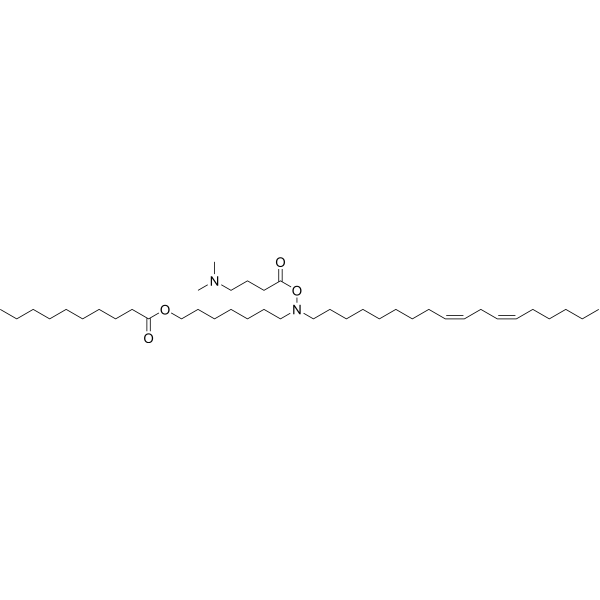
|
| DC60465 | Lipid R6 |
R6 is a new ionizable lipid driven from AI-Guided Ionizable Lipid Engineering (AGILE) platform for mRNA delivery.
More description
|

|
| DC65625 | C12-SPM |
C12-SPM is a polyamine branched-chain lipidoid.
More description
|

|
| DC65624 | RM 137-15 |
RM 137-15 is an ionizable cationic lipid that has been used in the formation of lipid nanoparticles (LNPs) for the delivery of mRNA in vivo.
More description
|

|
| DC60455 | RM133-3 |
RM133-3 is an ionizable lipid for potent functional mRNA delivery in vivo. The LPN formulation RM133-3-21, is found to be roughly 4.5 times more potent than DLin-MC3-DMA.
More description
|

|
| DC60474 | OC2-K3-E10 |
OC2-K3-E10 is an ionizable cationic lipid (pKa = 6.8).1 It has been used in the formation of lipid nanoparticles (LNPs) for the delivery of CRISPR complementary single-guide RNA (sgRNA) and Cas9 mRNA for genome editing in transgenic mice.
More description
|
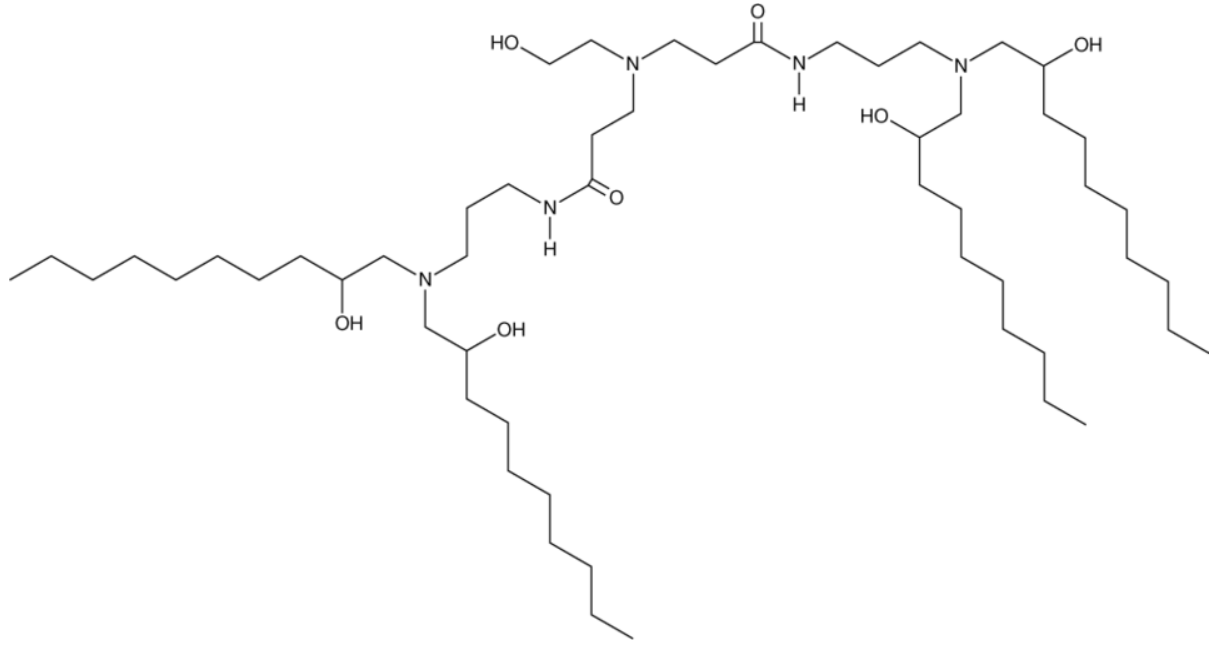
|
| DC86805 | Lipid 23 |
Lipid 23 is an ionizable cationic amino lipid (pKa = 5.7) that has been used with other lipids in the formulation of lipid nanoparticles (LNPs). Intravenous administration of LNPs containing lipid 23 and encapsulating an mRNA reporter accumulate specifically in the mouse liver.
More description
|

|
| DC60477 | Lipid Catechol |
Lipid catechol is a lipid that contains an α-aminophosphonate group, two 14-carbon acyl chains, and a catechol ring that forms a covalent bond with boronic acid-containing compounds to form lipid prodrug nanoassemblies (LPNA).1 LPNAs composed of lipid catechol conjugated to phenylboronic acid-modified ciprofloxacin (CIP-PBA) inhibit the formation of, and disrupt preformed, S. aureus biofilms and eradicate staphylococci in a mouse model of peritoneal S. aureus infection. LPNAs composed of lipid catechol conjugated to bortezomib (BTZ) reduce tumor growth and increase survival in a 4T1 murine mammary carcinoma model.
More description
|

|
| DC60476 | 1O14 |
1O14 is an ionizable cationic lipid that has been used in combination with other lipids in the formation of lipid nanoparticles (LNPs).
More description
|
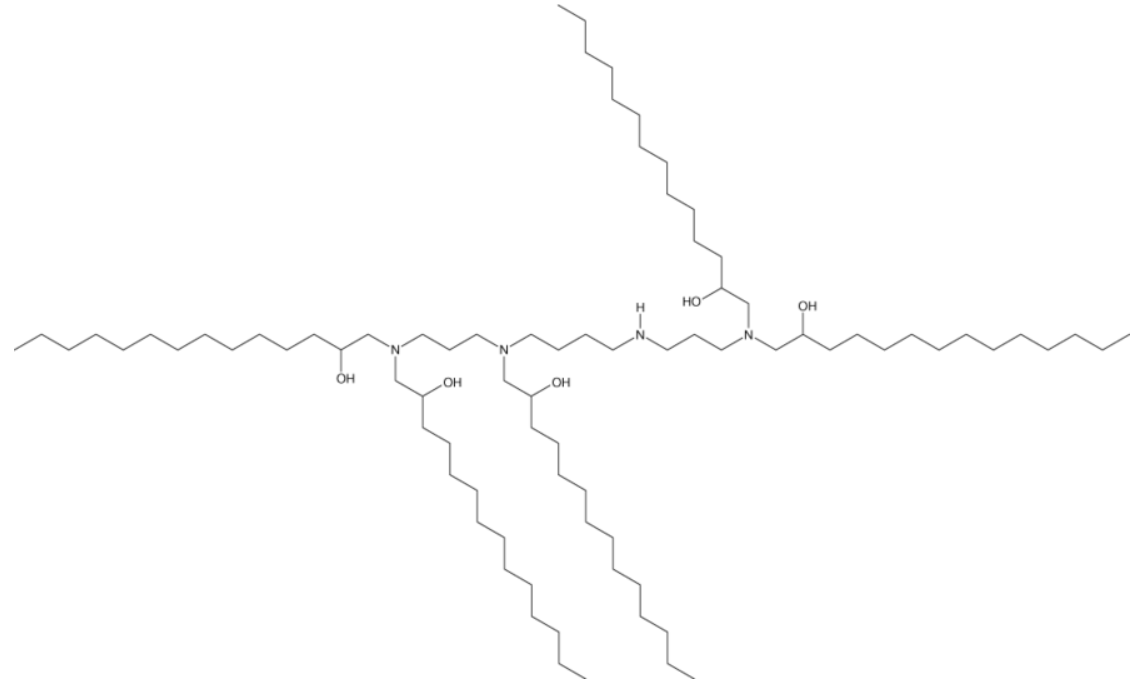
|
| DC81060 | ATX-001 |
ATX-001 is a novel ionizable cationic lipid compound for RNA delivery.
More description
|

|
| DC67135 | Lipid B37 |
Lipid B37 (B37) is an ionizable amino lipid, which can be used to form lipid nanoparticles and deliver mRNA.
More description
|
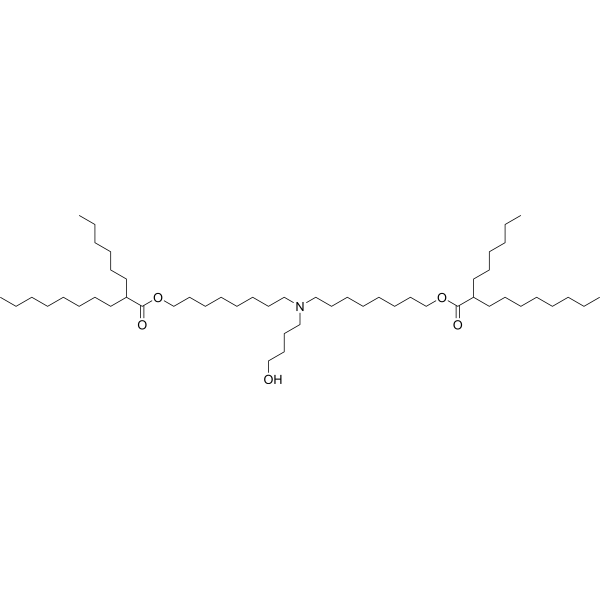
|
| DC65626 | C14-SPM |
C14-SPM is a polyamine branched-chain lipidoid.1 It has been used in combination with other lipids in the formation of lipid nanoparticles (LNPs) for the delivery of siRNA.
More description
|

|
| DC60429 | 16:0 DAP |
16:0 DAP, 1,2-dipalmitoyl-3-dimethylammonium-propane, is a cationic lipid that can be used to formulate lipid nanoparticles (LNPs). 18:0 DAP also serves as a pH-sensitive transfection reagent. Reagent grade, for research use only.
More description
|

|
| DC65348 | DOG-IM4 |
DOG-IM4 is an ionizable cationic lipid (apparent pKa = 5.6) that has been used in the generation of lipid nanoparticles (LNPs) for the delivery of mRNA.1 Immunization with LNPs containing DOG-IM4 and encapsulating mRNA encoding influenza A hemagglutinin (HA) increases HA-inhibiting antibody titers (HI titers) in mice and cynomolgus macaques.
More description
|

|
| DC60407 | C13-112-tetra-tail |
C13-112-tetra-tail is an advanced ionizable lipid molecule designed for use in lipid nanoparticles (LNPs) to deliver anionic substrates, such as nucleic acids (e.g., siRNA, mRNA) or proteins, both in vitro and in vivo.
More description
|

|